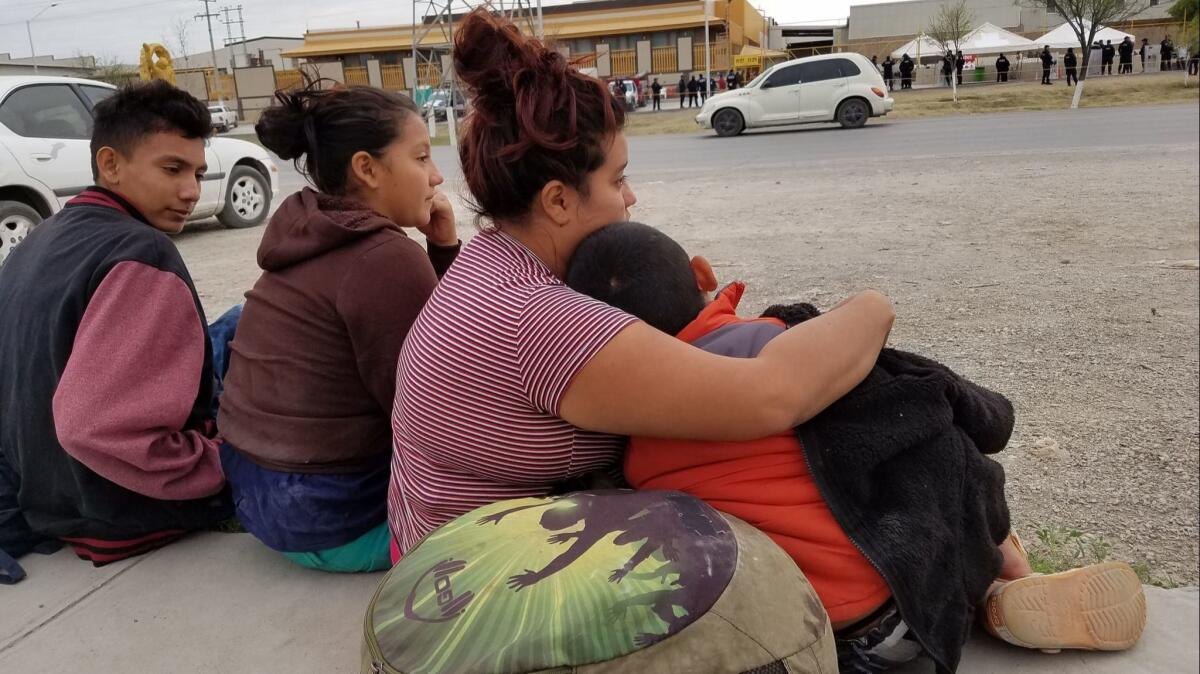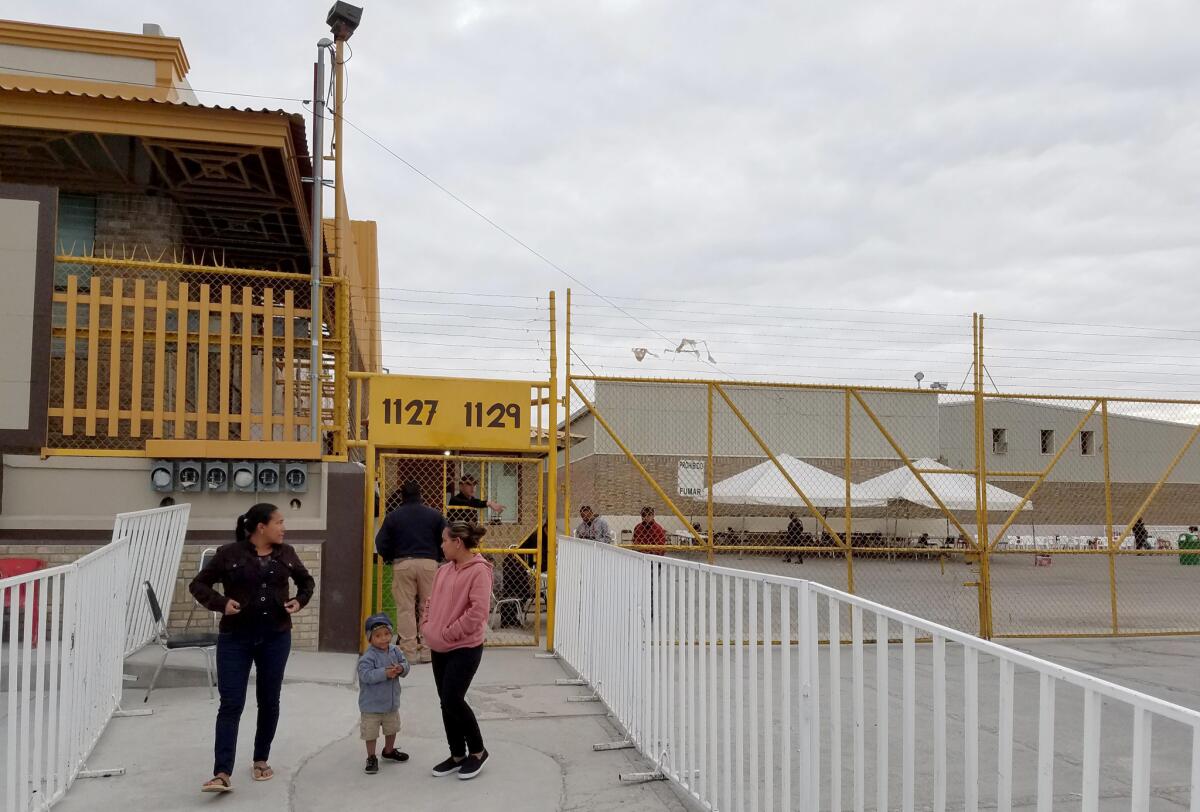Trump prevails as Mexican officials stop caravan at Texas border and ship migrants to other cities

- Share via
Reporting from Piedras Negras, Mexico — Last week, a caravan of 1,800 Central American migrants arrived in this isolated Mexican border city, where police ushered them into a makeshift government shelter at a shuttered factory surrounded by chain-link fence.
As conditions at the shelter deteriorated, riots erupted last Wednesday. Migrants broke through security barriers and struggled with guards. Some threw pipes, tables, chairs and parts of a tent at Mexican officers. Migrant advocates and reporters were barred from the facility, which was surrounded by dozens of federal police in riot gear.
On the other side of the Rio Grande, in the sleepy town of Eagle Pass, Texas, 250 troops and scores of Border Patrol agents were sent to shore up defenses as President Trump vowed to stop this latest caravan.
For the moment, Trump appears to have gotten his way.
As of Tuesday, the shelter was closing, with all but one group of migrant family members sent to other, larger border cities, where prospects of entering the United States were little better.
The last 18 migrants would be allowed to seek asylum at the border bridge to Texas, officials said. Speaking through the shelter fence Tuesday, some said they had proof, including photos, that they were fleeing persecution. It wasn’t clear why they were chosen, while others were not allowed to reach the city’s two border bridges across the Rio Grande. But a Honduran official said the overall group of 1,800 was simply too large for U.S. officials to process there.
“There isn’t space,” said Jose Carlos Ponce, the Honduran consul in Saltillo who was at the shelter Tuesday.
U.S. officials have said they generally process 15 asylum seekers a day at Eagle Pass, but increased that to about 20 after the caravan arrived.
In Roma, Texas, residents must choose: Help Border Patrol, or border crossers? »
Local officials in Piedras Negras paid to bus most of the caravan travelers to larger Mexican cities, including Juarez, Hermosillo, Monterrey and Reynosa, according to a psychologist with Doctors Without Borders, which was on hand to provide healthcare. Juarez and Reynosa are on the border across from the Texas cities of El Paso and Hidalgo, respectively. Hermosillo and Monterrey are in the Mexican interior.
“There’s a list of sites. They decide,” said the psychologist, Yovanna Lopez, as she sat outside the shelter where she had been treating migrants for nearly a week.

It wasn’t clear how many were leaving by choice.
“I don’t want to leave,” Merlin Linares Rodriguez, 23, said late Monday.
The Salvadoran single mother was traveling with son Jose Garcia Linares, 7, to join a friend in San Francisco.
“We tried to do it legally. They just tell us it’s not allowed,” she said, and began to cry as she sat by the side of the road opposite the shelter, hoping for a ride to the river where she would try to cross illegally.
When officials started allowing migrants to leave the shelter for short periods this week, Linares said she saw some asylum seekers attempt to cross the border bridges.
“They tear up your visa,” she said of Mexican officials stationed at the bridges.
Leyli Rodriguez, 26, fled Nicaragua with her two cousins to join her sister in Midland, Texas, but said Mexican officials at the shelter told them U.S. holding areas for asylum seekers were full.
“They said we can go to Reynosa, but we don’t want to. It’s dangerous. We could get kidnapped,” she said. “This is the safest place to be on the border.”
The migrants will probably join swelling waiting lists of asylum seekers as the U.S. expands a new policy forcing them to remain in Mexico after applying for asylum. Already, other asylum seekers have been turned back in Tijuana, and Trump administration officials said they planned to expand the policy to Piedras Negras.
Piedras Negras (population 150,000) and its sister city, Eagle Pass (population 28,000), fit a familiar pattern on the border: The Mexican city dwarfs its U.S. counterpart. Eagle Pass is an outpost, a setting for the films “No Country for Old Men” and “Lone Star.” Below the border bridges is a golf course, where carts passed a dozen Border Patrol trucks Tuesday. Neither city has the immigrant advocacy groups found in other border communities such as Brownsville, El Paso or San Diego.
In those cities, U.S. lawyers have volunteered to accompany migrants seeking asylum at border bridges, assisting them if authorities attempt to bar them from entering. But migrants at the Piedras Negras shelter said no lawyers were allowed into the shelter to help them seek asylum.
Outside the shelter, uniformed Mexican immigration officials sat at tables with laptops issuing temporary identification cards and visas that allowed the Central Americans to travel within the country, some for just a few weeks.
“If they try to cross illegally, the card is void,” said Manuel Gamez Reyes, a spokesman for the city stationed at the shelter.
About 300 of the migrants were granted permission to stay and work in Mexico, he said. The rest had to relocate. He acknowledged that most of the migrants were fleeing violence in Central America. But he said cities like his can’t help them.
“This is not a permanent shelter,” Gamez said, gesturing to a pile of scores of pallets in the parking lot outside that migrants had been given so they could sleep on the factory floor.
It would cost the city $260,000 to operate the shelter for a month, including food, staff and utilities, he said. He’s been working 12-hour days.
Gamez remembered feeling relieved when the first caravan went to Tijuana in December. This group moved more rapidly, he said, with help from municipal officials in Mexico’s interior.
Trump declares border emergency, testing the limits of presidential authority »
“Nobody wants them in their cities because it’s a lot of spending,” he said. “It’s better for us if they leave. We’re a small city. We can’t afford the costs.”
The buses were a Catch-22 for some of the migrants, a return to cities where they already failed to cross.
Francisco Banegas, 29, said he joined the caravan to Piedras Negras after being deported to his native Honduras during the December caravan to Tijuana. The construction worker and father of four left the shelter this week with a temporary visa hoping to find work to save the $6,000 he estimates he’ll need to pay a smuggler to get him across the Rio Grande illegally.
“What else am I supposed to do?” he said.
Luci Herrera Castillo said she fled Honduras with her two children after her 14-year-old daughter was raped last fall and the rapist’s father, a neighbor, threatened them. A single mother who worked doing washing and ironing, Herrera has another daughter she hoped to join in San Jose.
“I want to present myself at the bridge, but they won’t let me,” she said of officials at the shelter. “They say we have to go.”
She planned to try her luck crossing the river illegally without a smuggler, whom she couldn’t afford. On Sunday night, she said, 20 migrants disappeared from the shelter, probably bound for the river.
“We’re the last because we don’t have money to cross the river,” said Yolanda Castaneda, a Honduran traveling with her 2-year-old son, Nemar, to join a friend in Kansas.
Castaneda, 26, knew the river passage was dangerous. On Thursday, Border Patrol agents found the body of a man floating near one of the border bridges. But she and Nemar would not be boarding the buses. They would try to cross the river, she said, even though her son didn’t know how to swim. By Tuesday, they were gone.
More to Read
Sign up for Essential California
The most important California stories and recommendations in your inbox every morning.
You may occasionally receive promotional content from the Los Angeles Times.














